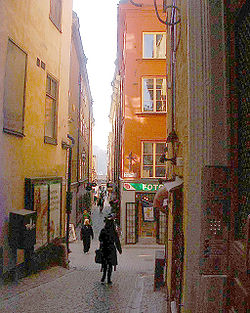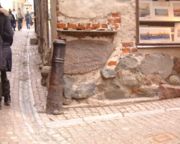
Kåkbrinken
Encyclopedia

Street
A street is a paved public thoroughfare in a built environment. It is a public parcel of land adjoining buildings in an urban context, on which people may freely assemble, interact, and move about. A street can be as simple as a level patch of dirt, but is more often paved with a hard, durable...
in Gamla stan
Gamla stan
Gamla stan , until 1980 officially Staden mellan broarna , is the old town of Stockholm, Sweden. Gamla stan consists primarily of the island Stadsholmen. The surrounding islets Riddarholmen, Helgeandsholmen, and Strömsborg are officially part of, but not colloquially included in, Gamla stan...
, the old town of Stockholm
Stockholm
Stockholm is the capital and the largest city of Sweden and constitutes the most populated urban area in Scandinavia. Stockholm is the most populous city in Sweden, with a population of 851,155 in the municipality , 1.37 million in the urban area , and around 2.1 million in the metropolitan area...
, Sweden
Sweden
Sweden , officially the Kingdom of Sweden , is a Nordic country on the Scandinavian Peninsula in Northern Europe. Sweden borders with Norway and Finland and is connected to Denmark by a bridge-tunnel across the Öresund....
. Stretching from the western waterfront Munkbroleden
Munkbroleden
Munkbroleden is a densely trafficked street passing along the western waterfront of Gamla stan, the old town in central Stockholm, Sweden...
to the central square Stortorget, it forms a parallel street to Yxsmedsgränd
Yxsmedsgränd
Yxsmedsgränd is an alley in Gamla stan, the old town in central Stockholm, Sweden.Stretching south from Västerlånggatan to Stora Nygatan, it forms a parallel street to Didrik Ficks Gränd and Kåkbrinken and is crossed by Lilla Nygatan and Munkbrogatan.Throughout its history it appears under various...
, Solgränd
Solgränd
Solgränd is an alley in Gamla stan, the old town of Stockholm, Sweden. It connects the Stortorget square to the street Prästgatan...
, and Bedoirsgränd
Bedoirsgränd
Bedoirsgränd is an alley in Gamla stan, the old town of Stockholm, Sweden. Stretching from Västerlånggatan to Stora Nygatan, it forms a parallel street to Kåkbrinken and Skräddargränd....
, while being crossed by Munkbrogatan
Munkbrogatan
Munkbrogatan is a street in the western part of Gamla stan, the old town in central Stockholm, Sweden. Stretching south between Munkbron and Mälartorget squares, it forms a parallel street to Munkbroleden and Lilla Nygatan, crossed by Yxsmedsgränd, Kåkbrinken, and Schönfeldts Gränd.Named after...
, Lilla Nygatan
Lilla Nygatan
Lilla Nygatan is a street in Gamla stan, the old town of Stockholm, Sweden. Stretching from the square Munkbron south to Kornhamnstorg, the street in intercepted by Yxsmedsgränd, Kåkbrinken, Schönfeldts Gränd, Tyska Brinken, and Lejonstedts Gränd, while forming a parallel street to Stora Nygatan...
, Stora Nygatan
Stora Nygatan
Stora Nygatan is a street in Gamla stan, the old town in central Stockholm, Sweden.Old names : nyegatun , nyia gaatan, den nya Konnungsgatun, stora konungsgatun , den store Nye gatan , Konnungsgatun , Nye gaten, KongsGaten , Kongs- eller stoora Nygatan, stora Kongs- el' Nygatan , Stora...
, Västerlånggatan
Västerlånggatan
Västerlånggatan is a street in Gamla stan, the old town of Stockholm, Sweden. Stretching southward between the squares Mynttorget and Järntorget, it follows the course of the city's now demolished 13th century defensive wall....
, and Prästgatan
Prästgatan
Prästgatan is a street in Gamla stan, the old town in central Stockholm, Sweden, stretching from a cul-de-sac west of the Royal Palace to the street Österlånggatan in the southern corner of the old town. Prästgatan forms a parallel street to Västerlånggatan, Trångsund, Skomakargatan, and...
.
Origin of the name
First mentioned in 1477, and in more detail in 1496, the street is called Kakbringkin, kak being old SwedishOld Swedish
Old Swedish is the name for two separate stages of the Swedish language that were spoken in the Middle Ages: Early Old Swedish , spoken from around 1225 until 1375, and Late Old Swedish , spoken from 1375 until 1526.Old Swedish developed from Old East Norse, the eastern dialect of Old Norse...
for modern Swedish kåk, today meaning "ramshackle house" or "prison", but at the time referring to a pillory
Pillory
The pillory was a device made of a wooden or metal framework erected on a post, with holes for securing the head and hands, formerly used for punishment by public humiliation and often further physical abuse, sometimes lethal...
placed on Stortorget. The pillory is first mentioned in connection to the so called "Käpplinge murders" (Käpplingemorden) in the first half of the 15th century - the story of a group of German burghers who trapped a large number of prominent citizens in a hovel on Blasieholmen (at the time called Käpplinge) and burned them in. The Germans are said to have been led from the Royal Palace
Stockholm Palace
The Stockholm Palace is the official residence and major royal palace of the Swedish monarch. . Stockholm Palace is located on Stadsholmen , in Gamla Stan in the capital, Stockholm...
to the pillory. A copper statue of a man holding a birch
Birch
Birch is a tree or shrub of the genus Betula , in the family Betulaceae, closely related to the beech/oak family, Fagaceae. The Betula genus contains 30–60 known taxa...
in his right hand, placed on top of the pillory in 1602, was replaced in 1647 by a new one in bronze still preserved in the Town Hall
Stockholm Court House
Stockholm Court House is situated on Kungsholmen in Central Stockholm, Sweden. The building was constructed between 1909 and 1915. The architecture is influenced by the Castles of the Vasa era and it bears a resemblance to Vadstena Castle...
. The pillory was moved to Norrmalmstorg
Norrmalmstorg
Norrmalmstorg is a square in central Stockholm. The square connects shopping streets Hamngatan and Biblioteksgatan and is the starting point for tram travellers with the Djurgården line...
in 1776, and from there to Eriksbergsplan in 1810.
On a map dated 1733, the upper part of the street, between Stortorget and Västerlånggatan, is called Kåkbrinken, while the lower part is given several names: Kocks gränd (referring to the burgher Ragvald Kock); Jokum bagares, Bagare gränd, Schultens gränd, and Nedre Schult gränd (referring to the baker Joachim Schult); Söte Gudmunds gränd Söte gummans gränd ("Alley of the Sweet Old Woman", Gudmund is also a proper name), Lasse Månssons gränd, Björn Perssons gränd, Mäster Eriks gränd (referring to men with those names), and Påfvel murmästares gränd ("Alley of Masonry master Paul"). Before the names of the streets of Gamla stan were fixed in 1885, the name 'Kåkbrinken' was used for various parts of its present extension.
The runestone

In the corner of Prästgatan and Kåkbrinken is a runestone in the wall, carrying the inscription "Torsten and Frögunn had the stone erected after their son.". The stone was probably brought to Stockholm to be used as building material, from where is not known. As the female name Frögunn is known as a pagan name, the stone is believed to be from around 1000, the stone thus being about 200 years older than the city.
A laser range scanner analysis made in 2002, showed variations in stroke patterns in the grooves of the stone, and that the stone was probably carved by a master carver and an apprentice. Its one of three runestones found in the old town: A second, U 274, originally located in a wall by the southern city gate near Slussen, is today kept in the Museum of Medieval Stockholm
Museum of Medieval Stockholm
The Museum of Medieval Stockholm , centrally located north of the Royal Palace, was constructed around old monuments excavated in an extensive archaeological dig in the late 1970s...
. It contains the words "Karl and Adisla had [this stone] erected [after] Arnsil, [their] father" and is similar in style to stones found in Södermanland
Södermanland
', sometimes referred to under its Latin form Sudermannia or Sudermania, is a historical province or landskap on the south eastern coast of Sweden. It borders Östergötland, Närke, Västmanland and Uppland. It is also bounded by lake Mälaren and the Baltic sea.In Swedish, the province name is...
, south of Stockholm. The third runestone, U 54, is today lost but was once located in a stairway in the church Riddarholmskyrkan
Riddarholmskyrkan
The Riddarholmen Church is the burial church of the Swedish monarchs. It is located on the island of Riddarholmen, close to the Royal Palace in Stockholm, Sweden. The congregation was dissolved in 1807 and today the church is used only for burial and commemorative purposes. Swedish monarchs from...
.
External links
- http://www.hitta.se/SearchCombi.aspx?__VIEWSTATE=%2FwEPDwUKMTg4NDI3NTMzNWRk&UCSB%3AWflWhite=1a1b&UCSB%3AWflPink=4a&SearchType=4&UCSB%3ABBX1=&UCSB%3ABBY1=&UCSB%3ABBX2=&UCSB%3ABBY2=&UCSB%3ATextBoxWho=&UCSB%3ATextBoxWhere=K%E5kbrinken&UCSB%3AButtonSearch=%A0%A0hitta%21%A0%A0&CombiResults%3AUserControlMapControl%3Acx=1562680&CombiResults%3AUserControlMapControl%3Acy=6818654&CombiResults%3AUserControlMapControl%3ApointsHidden=&CombiResults%3AUserControlMapControl%3Az=9hitta.se - location map]
- Christer Hamp - Image of the runestone found at Södersluss (Sö 274)

